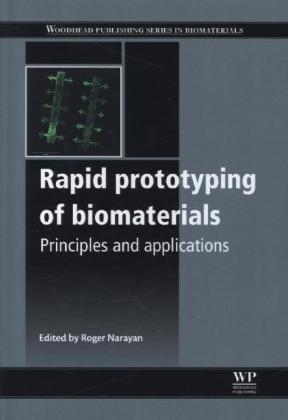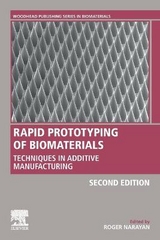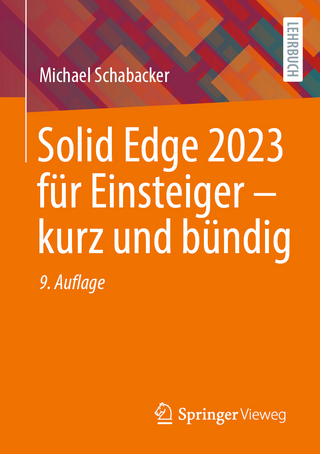
Rapid Prototyping of Biomaterials
Woodhead Publishing Ltd (Verlag)
978-0-85709-599-2 (ISBN)
- Titel erscheint in neuer Auflage
- Artikel merken
Rapid Prototyping of Biomaterials: Principles and Applications provides a comprehensive review of established and emerging rapid prototyping technologies (such as bioprinting) for medical applications. Rapid prototyping, also known as layer manufacturing, additive manufacturing, solid freeform fabrication, or 3D printing, can be used to create complex structures and devices for medical applications from solid, powder, or liquid precursors.
Following a useful introduction, which provides an overview of the field, the book explores rapid prototyping of nanoscale biomaterials, biosensors, artificial organs, and prosthetic limbs. Further chapters consider the use of rapid prototyping technologies for the processing of viable cells, scaffolds, and tissues.
With its distinguished editor and international team of renowned contributors, Rapid Prototyping of Biomaterials is a useful technical resource for scientists and researchers in the biomaterials and tissue regeneration industry, as well as in academia.
Dr. Roger Narayan is a Professor in the Joint Department of Biomedical Engineering at the University of North Carolina and North Carolina State University. He is an author of more than 100 publications as well as several book chapters on nanostructured biomedical materials. Dr. Narayan has received several honors for his research activities, including the NCSU Alcoa Foundation Engineering Research Achievement Award, the NCSU Sigma Xi Faculty Research Award, the University of North Carolina Jefferson-Pilot Fellowship in Academic Medicine, the University of North Carolina Junior Faculty Development Award, the National Science Faculty Early Career Development Award, the Office of Naval Research Young Investigator Award, and the American Ceramic Society Richard M. Fulrath Award. He has been elected as Fellow of the American Ceramic Society, the American Association for the Advancement of Science, the American Institute for Medical & Biological Engineering, and ASM International.
Contributor contact details
Woodhead Publishing Series in Biomaterials
Introduction
Chapter 1: Introduction to rapid prototyping of biomaterials
Abstract:
1.1 Introduction
1.2 Definition of rapid prototyping (RP) systems
1.3 Basic process
1.4 Conventional RP systems and classification
1.5 RP of biomaterials
1.6 Conclusion and future trends
1.7 Sources of further information and advice
Chapter 2: Freeform fabrication of nanobiomaterials using 3D printing
Abstract:
2.1 Introduction
2.2 Laser-based solid freeform fabrication (SFF) techniques
2.3 Droplet-based SFF techniques
2.4 Nozzle-based SFF techniques
2.5 Extrusion freeforming of biomaterials scaffold
2.6 Dry powder printing
2.7 Conclusion
Chapter 3: Rapid prototyping techniques for the fabrication of biosensors
Abstract:
3.1 Introduction
3.2 Rapid prototyping (RP) of microfluidic systems
3.3 Functionalization
3.4 Biomaterials compatibility
3.5 Conclusion and future trends
3.6 Sources of further information and advice
Chapter 4: Rapid prototyping technologies for tissue regeneration
Abstract:
4.1 Introduction
4.2 Rapid prototyping (RP) technologies in tissue regeneration
4.3 Laser-assisted techniques
4.4 Extrusion-based techniques
4.5 Inkjet printing (IP)
4.6 Conclusion
Chapter 5: Rapid prototyping of complex tissues with laser assisted bioprinting (LAB)
Abstract:
5.1 Introduction
5.2 Rationale for using laser assisted bioprinting (LAB) in tissue engineering
5.3 Terms of reference for LAB
5.4 LAB parameters for cell printing
5.5 High resolution and high throughput needs and limits
5.6 Applications of LAB
5.7 Conclusion
5.8 Acknowledgements
Chapter 6: Scaffolding hydrogels for rapid prototyping based tissue engineering
Abstract:
6.1 Introduction
6.2 Biomaterials in tissue engineering
6.3 Review of commonly used hydrogel-forming scaffolding biomaterials
6.4 Applications of scaffolding hydrogels
6.5 Conclusion
Chapter 7: Bioprinting for constructing microvascular systems for organs
Abstract:
7.1 Introduction
7.2 Biomimetic model for microvasculature printing
7.3 The bio-blueprint for microvasculature printing
7.4 Microvasculature printing strategies
7.5 Microvasculature post-printing stage
7.6 Future trends
7.7 Acknowledgements
Chapter 8: Feasibility of 3D scaffolds for organs
Abstract:
8.1 Introduction
8.2 Overview of organ fabrication
8.3 The right place: physical properties of the scaffold
8.4 The right time: temporal expectations on the scaffold
8.5 The right biomaterials: scaffold fabrication effects on non-scaffold components
8.6 The right characteristics: material types
8.7 The right process: biofabrication
8.8 Conclusion
8.9 Sources of further information and advice
Chapter 9: 3-D organ printing technologies for tissue engineering applications
Abstract:
9.1 Introduction
9.2 Three-dimensional printing methods for organ printing
9.3 From medical imaging to organ printing
9.4 Applications in tissue engineering and regenerative medicine
9.5 Future trends
9.6 Conclusion
Chapter 10: Rapid prototyping technology for bone regeneration
Abstract:
10.1 Introduction
10.2 Bone: properties, structure, and modeling
10.3 Engineering of bone tissue
10.4 Conventional scaffolds for bone regeneration
10.5 Cell printing technology for bone regeneration
10.6 Future trends
10.7 Conclusion
10.8 Acknowledgement
Chapter 11: Additive manufacturing of a prosthetic limb
Abstract:
11.1 Introduction
11.2 The aim in designing a prosthetic limb
11.3 A biomimetic approach to design
11.4 Integrating functionality
11.5 A ‘greener’ approach to design
11.6 Tactile dividends of additively manufactured parts
11.7 Vast design flexibility
11.8 Conclusion
Index
| Reihe/Serie | Woodhead Publishing Series in Biomaterials |
|---|---|
| Verlagsort | Cambridge |
| Sprache | englisch |
| Maße | 156 x 234 mm |
| Gewicht | 640 g |
| Themenwelt | Technik ► Maschinenbau |
| Technik ► Umwelttechnik / Biotechnologie | |
| ISBN-10 | 0-85709-599-4 / 0857095994 |
| ISBN-13 | 978-0-85709-599-2 / 9780857095992 |
| Zustand | Neuware |
| Informationen gemäß Produktsicherheitsverordnung (GPSR) | |
| Haben Sie eine Frage zum Produkt? |
aus dem Bereich



